It all began — as most great stories do — in a bar.
In November 2015, Nature Conservancy scientist Richard Hamilton was staying at a remote lodge en route to conducting scientific fieldwork in the Solomon Islands. Passing through the thatched-roof restaurant, he noticed several strange nautilus shells tucked above the bar, alongside other shells and driftwood washed up on the island’s beaches.
But these weren’t your typical nautilus shells — they belonged to the rare species Allonautilus scrobiculatus, which had never before been caught alive in the Solomon Islands.
Hamilton, director of the Conservancy’s Melanesia program, had only months earlier been one of the few western scientists to ever catch an Allonautilus alive off of Manus, Papua New Guinea. The lodge’s owner confirmed that the shell behind the bar was found locally, meaning that Hamilton now had tantalizing evidence that the Allonautilus might be found off of the Solomon Islands, too.
All he had to do was catch one, and he had good reason to feel optimistic.
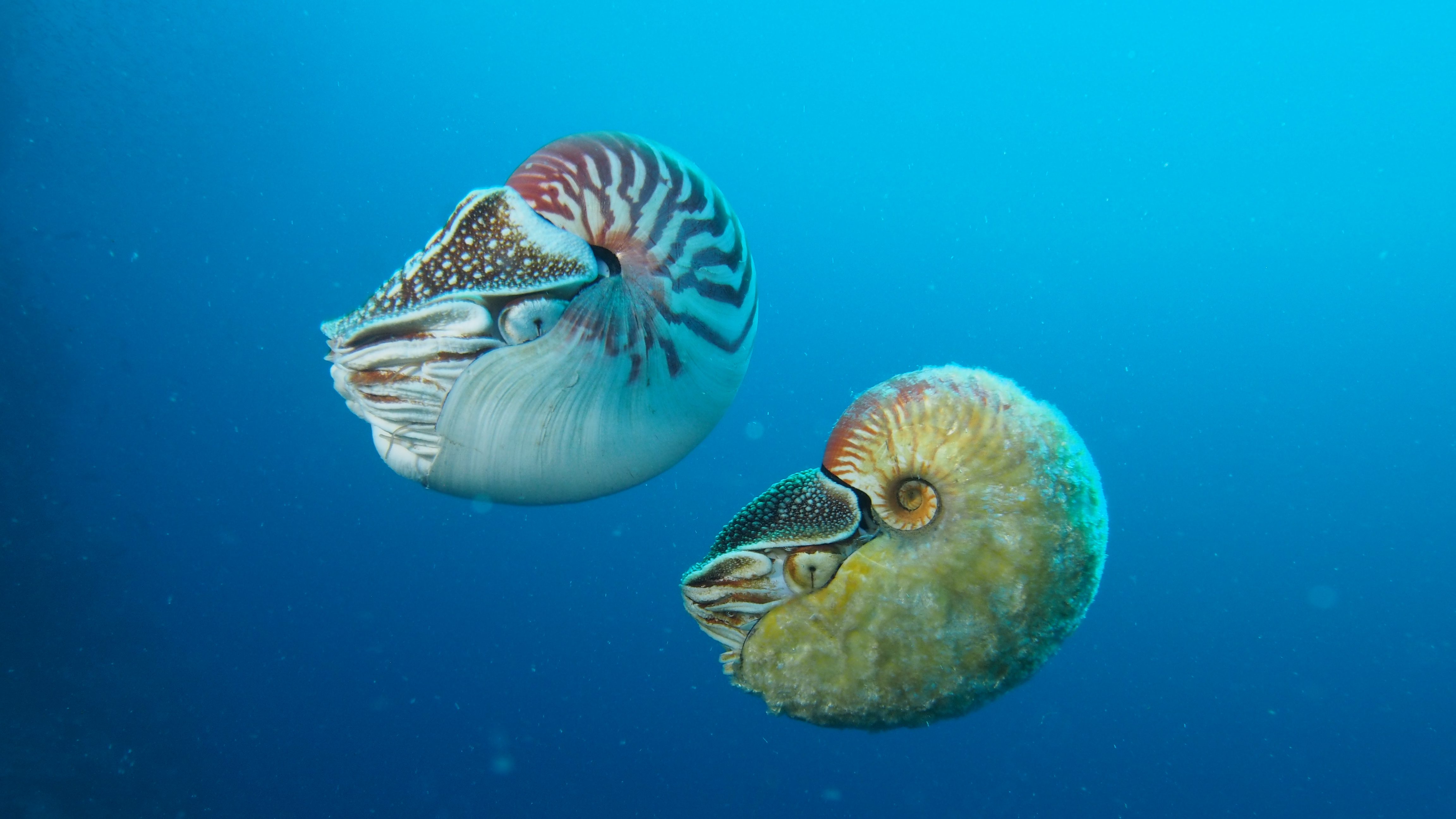
Rare, Mysterious, and Ugly
Amongst nautilus species, A. scrobiculatus isn’t winning any beauty contests. The species has a skin-like layer of protein, called the periostracum, covering its shell. A non-scientist might describe it as resembling an erratic coating of snot.
In 1984, scientists Peter Ward and Bruce Saunders were the first researchers to ever catch an Allonautilus alive off the coast of Manus, Papua New Guinea. Three decades later, Ward and Hamilton joined forces to seek out — and successfully catch — the species a second time. (Read Hamilton’s account of that expedition here.)
But telltale shells washed up elsewhere in PNG and the Solomon Islands suggest that Manus perhaps isn’t the only place the Allonautilus are found. “A recent genetic study that has been done on this species suggests that it might have a larger distribution than what we see from the limited trapping data available,” says Hamilton.
After all, how many people run around dropping nautilus traps in the remote South Pacific? Hint: not many.
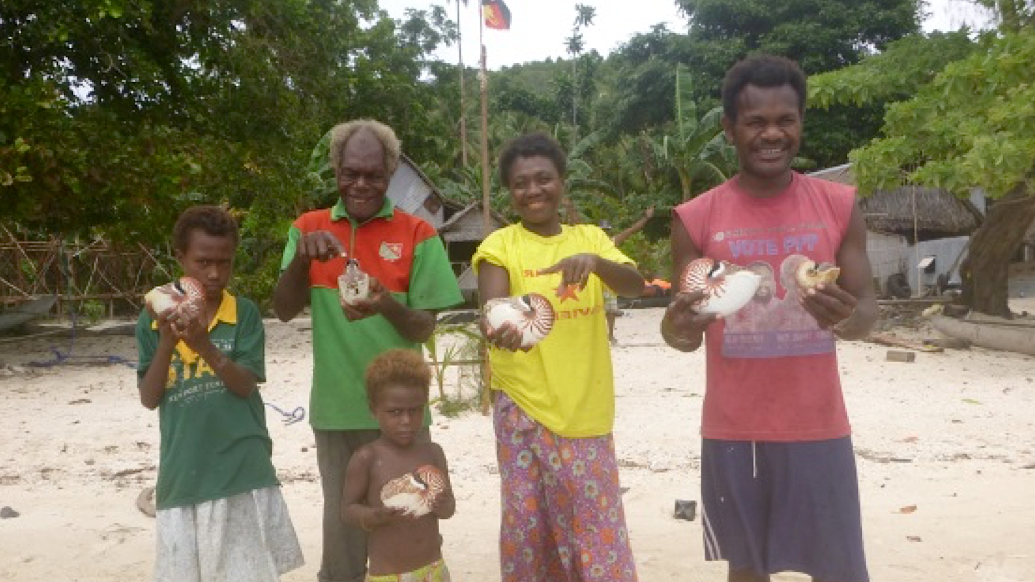
Hamilton searched for the Allonautilus again off of Kaveing, PNG in September 2015, with no luck. But Tapas Potuku, the Conservancy’s community conservation officer in New Ireland Province kept at it, dropping trap after trap off of Mait Island. On the third day he hauled up a single juvenile Allonautilus, making him the only person in the world to catch a live Allonautilus outside of Manus. The following month he again dropped another trap — just for fun — and caught a second Allonautilus.
First Manus, and then New Ireland. But what about the Solomon Islands?
Previous surveys in the Solomon Islands failed to find the Allonautilus, but Hamilton explains that trapping for a low-distribution species that lives hundreds of meters below the surface in remote waters isn’t the most reliable species distribution data. In addition to the two shells at the resort bar, the Arnavon Islands conservation officers reported that they too have found Allonautilus shells washed up on the protected area’s beaches.
“I think there’s a good chance it’s here,” says Hamilton, “but whether or not we will find it is to some extent dumb luck.”

How To Build A Nautilus Trap: A Guide
How exactly do you catch a rare nautilus, you ask? You’re going to need a trap. And your average Home Depot doesn’t have an aisle for sea-creature traps, and even if they did the Arnavon Islands research station doesn’t have a Home Depot. So you’re going to have to build it yourself.
Step 1: Save the head and guts from your fish lunch, and set aside in the midday sun as far away from camp as possible. You’ll need them later.
Step 2: Make sure your packing list for the remote tropical research station includes a swashbuckling jack-of-all-trades Aussie gas fitter who doesn’t mind welding steel rebar in 90 degree tropical heat. Also, don’t forget the rebar.
Step 3: Stretch and weave chicken wire over the meter-square frame, covering all six sides, and secure with zip ties. Next, cut a 10-inch diameter hole in the middle of one side, weaving the chickenwire back to form a funnel that narrows into the trap. (Nautilus aren’t very clever, so you really don’t need to worry about them finding their way out.)
Step 4: Weight the bottom corners of the trap down with extra dive weights and/or random chunks of steel lying around the island. Then, secure a good 400 meters of bright-yellow rope to the top.
Step 5: Weave small basket from the remaining chickenwire and load in your now-rancid fish parts. (Don’t forget the head.) Then reach inside the nautilus trap and suspend this basket from the top with a few zipties. Make sure the entrails and/or liver are dangling outside of the chicken wire for optimal nautilus-attracting.
Step 6: Find four able-bodied helpers (who aren’t passed out in the nearby hammock) and load the nautilus trap into the boat, making sure to place it as far up the bow as possible to stink up the entire 1.5-hour ride.
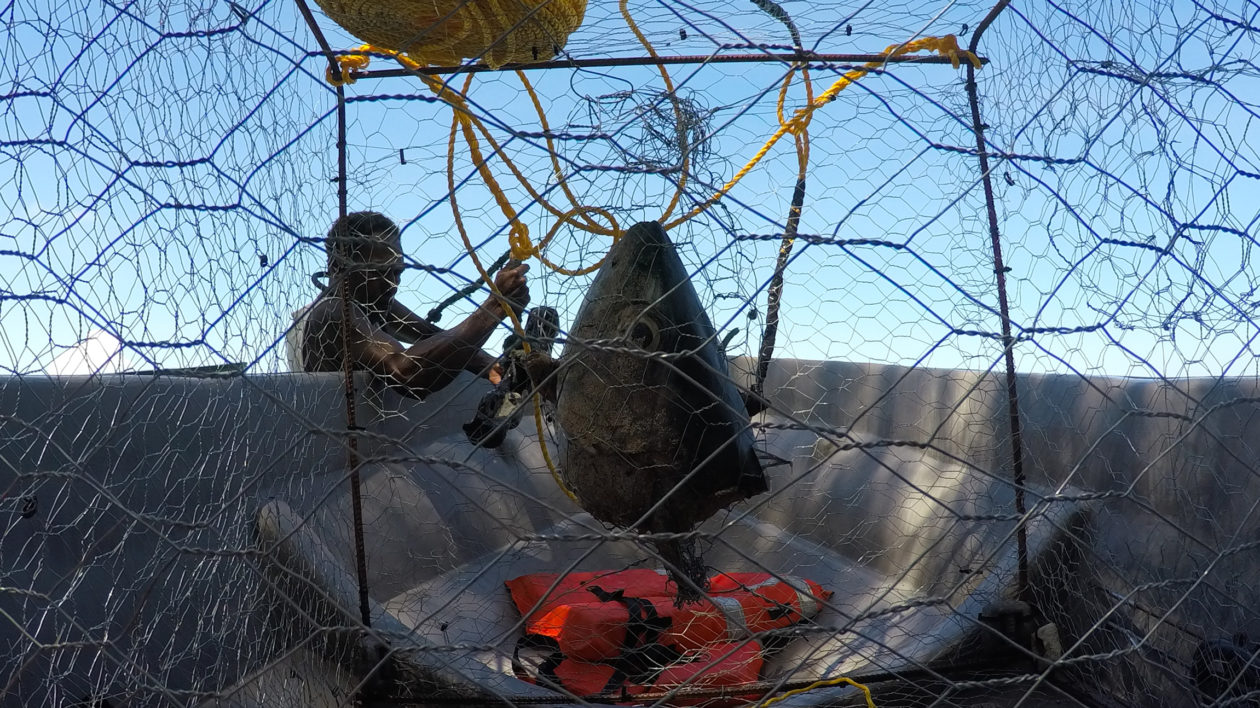
High Swells & Stinky Bait
With the trap assembled and lunch digested, Hamilton, the Arnavons conservation officers, myself, and a handful of other Conservancy colleagues piled into the boats. We had a 1.5-hour journey across the Manning Straight to the deployment site — and I’d been clever enough to pick the boat with the pungent trap in the bow.
Hamilton wanted to deploy the trap off of the very northwestern tip of Isabel Island, where the reef drops off steeply to a mud-bottom plain several hundred meters below the surface. “We found them at similar depths in Manus, just off the reef slope,” says Hamilton.
Less than two bumpy hours later we were there, trap-builder extraordinaire Mick Murray peering carefully at the GPS as Hamilton shouted directions to the boat drivers. We were as close as we could tell. Hamilton and the conservation officers carefully tipped the trap overboard, counting out meters as the massive spools of yellow rope unwound. The line went slack at about 320 meters, more or less what the GPS dictated, and we tied off the buoys.
Which was then followed by a heated debate and mutual pronunciation lesson in the different pronunciations of the word ‘buoy’ in Australian and American English. (Dear Aussies, I can’t pronounce all of your vowels.)
I think there’s a good chance it’s here, but whether or not we will find it is to some extent dumb luck.
Richard Hamilton
This Is Not the Nautilus You’re Looking For
The next day we headed out again to retrieve the trap. Excitement was high — would we really catch an Allonautilus on the first go? — but not as high as the swells, which necessitated some serious focus on the horizon for all but the heartiest of sailors. (Read: Hamilton and the local conservation officers were fine.)
Meter by meter of yellow rope piled into the bottom of the boat, and as the trap shimmered into focus Hamilton grabbed a snorkel and mask and pitched into the water. Seconds later he surfaced — we had a nautilus, but not the nautilus we were looking for. A single Nautilus pompilius had blundered into our trap — the much more common species already known to the area.
I was still pleased as punch. I was holding a species whose genetics program it to grow a shell into a perfect logarithmic spiral. A species where the first fossils date back million years ago in the early Pleistocene, when ground sloths and saber-toothed cats were trundling around land and the newly evolved Homo habilis was whacking out the first stone tools and undertaking the great migration out of Africa. And a species whose family, the Nautiloids, date back a whopping 500 million years.
This was awesome.
With the seas still rolling we hauled the trap back into the boat to re-bait — this time with freshly killed chicken — and chucked the whole rig back overboard. We’d be back tomorrow for another go.
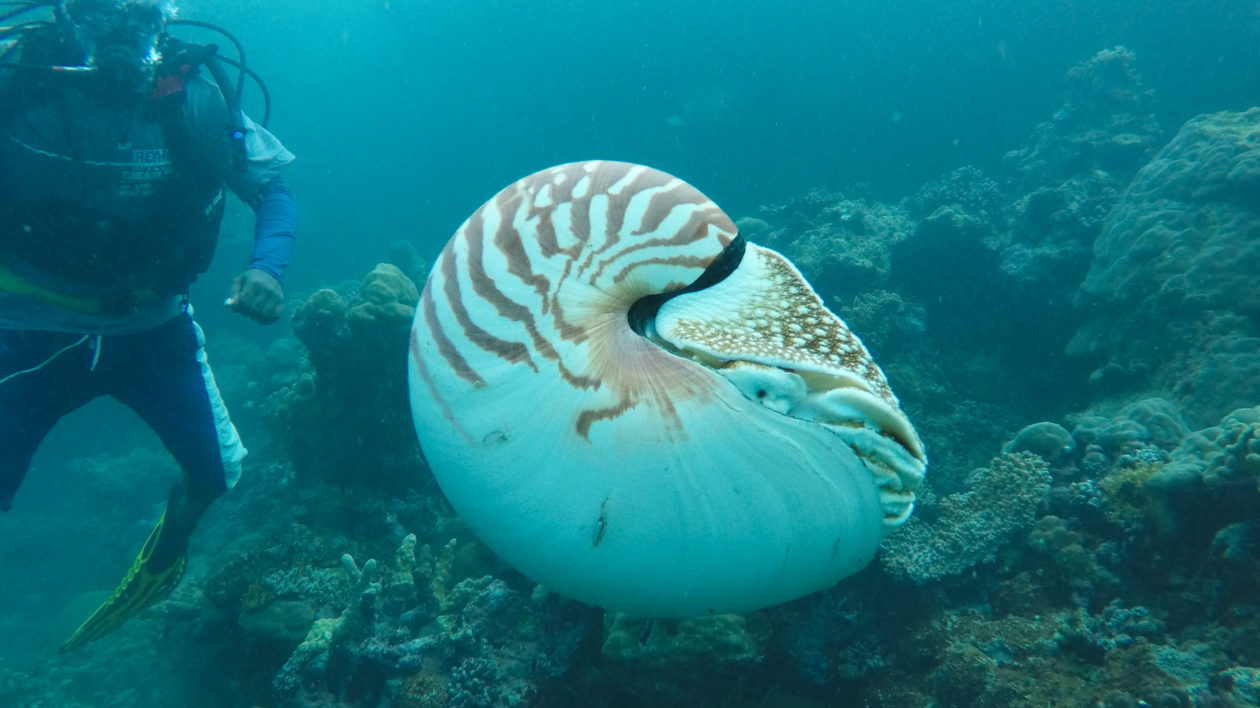
A Buoyless Open Sea
Wednesday morning, and we were back for another check on the trap. Motoring out of the mangrove-lined channel, we all kept our eyes peeled for the buoys as we transitioned from reef to open water. Nothing.
This was not good. Yesterday the yellow and white buoys were visible from 100 meters away against the blue-black sea. But not today. All of us scanned furiously, each checking a different direction on the horizon as the swells lifted and swayed. Hamilton checked the GPS — we were in the right spot. Still nothing.
After 20 minutes we had to face the truth — the trap was gone, either pulled inland by currents and the previous’ night storms, or simply cut loose from the buoys by local fishermen. The third option was the most hopeful: Hamilton suspected that local fisherman had found the buoys, hauled up the trap, and not knowing who it belonged to kept it for themselves. “If someone hauled it up we’ll find it, eventually,” says Hamilton.
Mickey, an expert local spear fisherman and volunteer on the trip, kindly offered to have his local witch-doctor make inquiries, but the fact remained that we’d have to return home empty handed.
And the search for the rare Allonautilus continues …
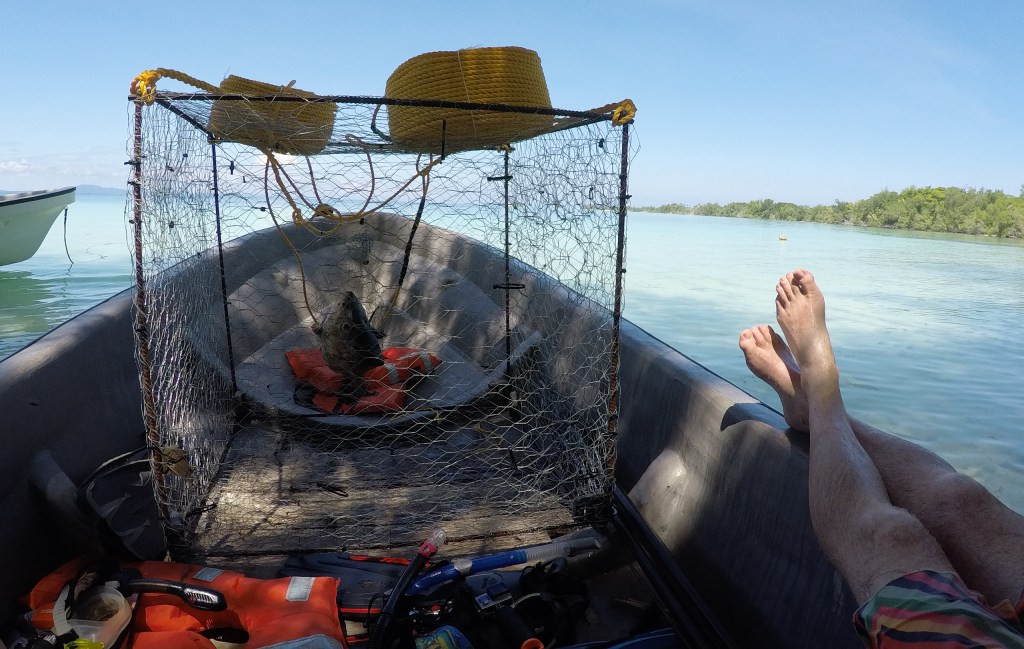



How exciting it is to be on the brink of finding a rare creature in a new place. Great article!